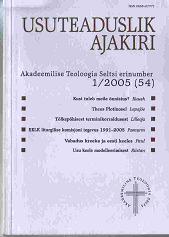Usu keele modelleerimisest
Modelling the Language of Faith
Author(s): Ain RiistanSubject(s): Christian Theology and Religion
Published by: Akadeemiline Teoloogia Selts
Keywords: Religious Language; Philosophy; Theology
Summary/Abstract: The article discusses the ways of modelling the language of faith in the different fields of academic study and its implications for theological inquiry. From the viewpoint of theology faith and its expression through language can be analysed in two main subcategories: „the faith what is believed in“ (fides quae creditur) and „the faith which believes” (fides qua creditur). While the difference can be made it is important to stress that these two categories appear always together. For example the models of analytical philosophy of verification and falsification can present the language of faith only as the examples of nonsensical use of language because they fail to take into account that „the faith what is believed in“ is always related to „the faith which believes“ (i.e. the meaning of a given belief is determined not only by its substance but also by the attitude of a believer). John L. Austin’s „speech act“ model helps to see how an attitude of a believing act can determine its meaning. However, the language of faith can also be analysed from the viewpoint of communication and here Roman Jakobson’s model of the functions of language serves theological inquiry particularly well. In the last part of the article this model is used in analysing the two examples of how the act of confessing one’s faith can have simultaneously different layers of meaning depending on the life-situation and intent of a believer.
Journal: Usuteaduslik Ajakiri
- Issue Year: 2005
- Issue No: 1 (54)
- Page Range: 79-104
- Page Count: 26
- Language: Estonian

